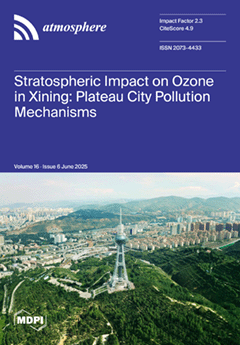This study investigates the temporal dynamics, sources, and photochemical behaviour of key volatile organic compounds (VOCs) along Marylebone Road, London (1 January 2015–1 January 2023), a heavily trafficked urban area. Hourly measurements of benzene, toluene, ethylbenzene, ethene, propene, isoprene, propane, and ethyne, alongside
[...] Read more.
This study investigates the temporal dynamics, sources, and photochemical behaviour of key volatile organic compounds (VOCs) along Marylebone Road, London (1 January 2015–1 January 2023), a heavily trafficked urban area. Hourly measurements of benzene, toluene, ethylbenzene, ethene, propene, isoprene, propane, and ethyne, alongside ozone (O
3) and meteorological data, were analysed using correlation matrices, regression, cross-correlation, diurnal/seasonal analysis, wind-sector analysis, PCA (Principal Component Analysis), and clustering. Strong inter-VOC correlations (e.g., benzene–ethylbenzene: r = 0.86, R
2 = 0.75; ethene–propene: r = 0.68, R
2 = 0.53) highlighted dominant vehicular sources. Diurnal peaks of benzene, toluene, and ethylbenzene aligned with rush hours, while O
3 minima occurred in early mornings due to NO titration. VOCs peaked in winter under low mixing heights, whereas O
3 was highest in summer. Wind-sector analysis revealed dominant VOC emissions from SSW (south-southwest)–WSW (west-southwest) directions; ethyne peaked from the E (east)/ENE (east-northeast). O
3 concentrations were highest under SE (southeast)–SSE (south-southeast) flows. PCA showed 39.8% of variance linked to traffic-related VOCs (PC1) and 14.8% to biogenic/temperature-driven sources (PC2). K-means clustering (k = 3) identified three regimes: high VOCs/low O
3 in stagnant, cool air; mixed conditions; and low VOCs/high O
3 in warmer, aged air masses. Findings highlight complex VOC–O
3 interactions and stress the need for source-specific mitigation strategies in urban air quality management.
Full article





